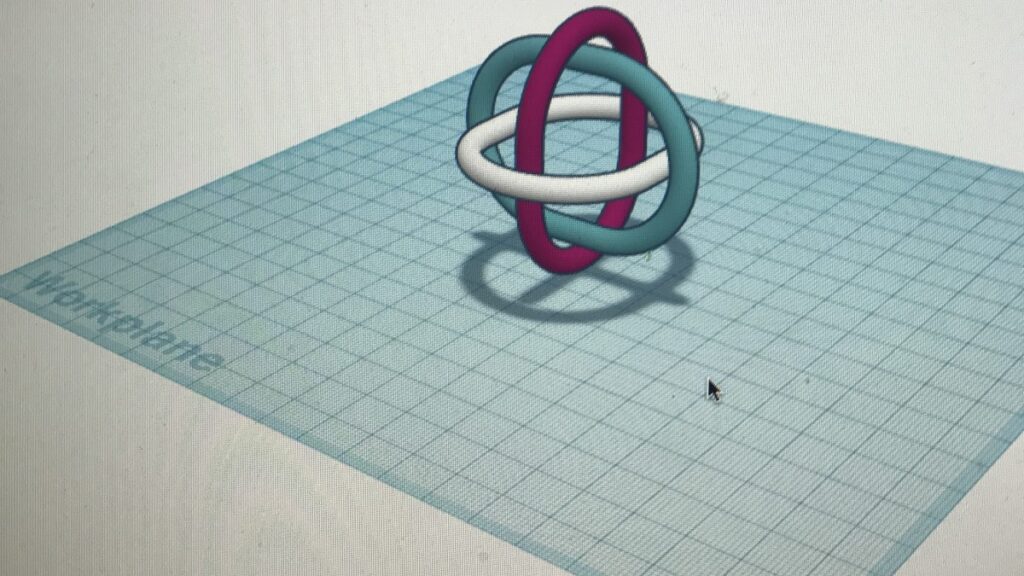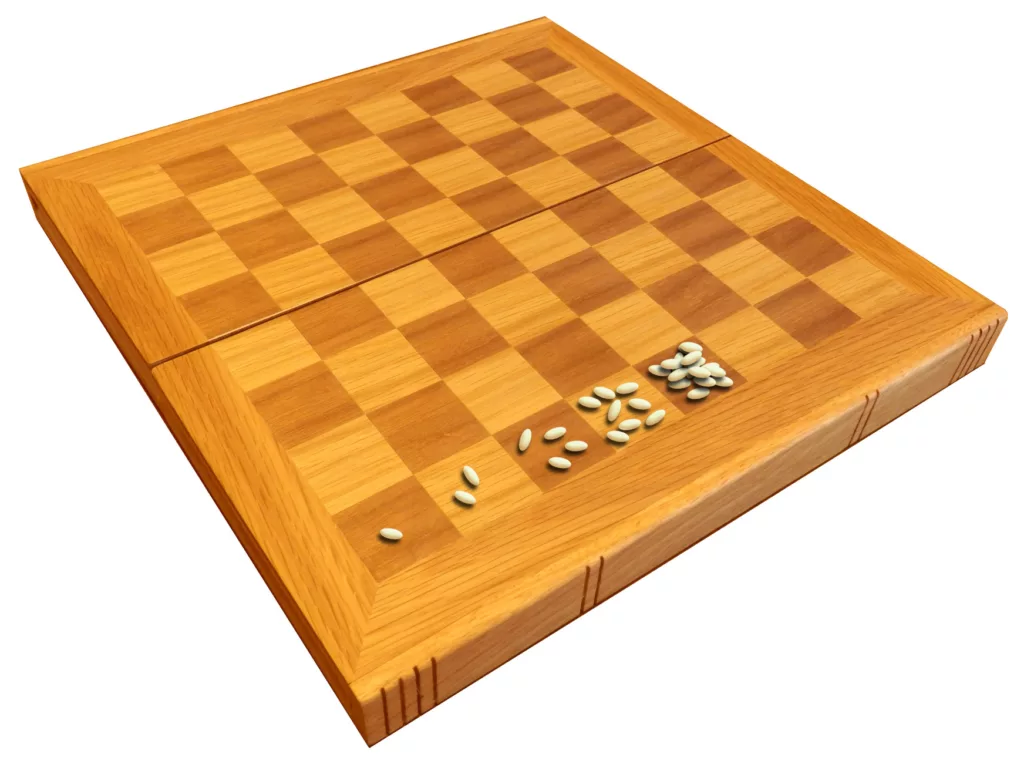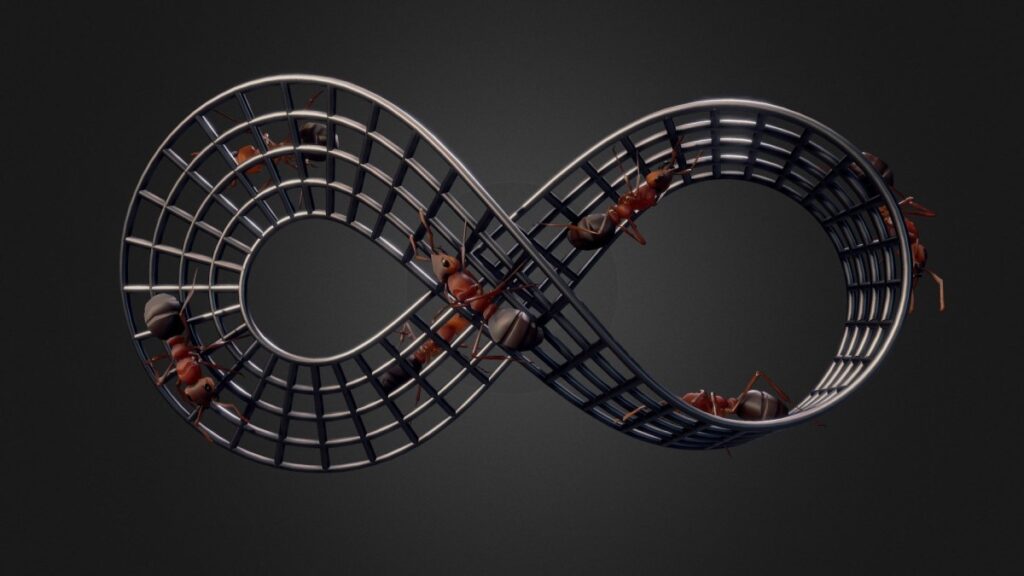Over the course of this article, you will discover mathematics in a new light as we will talk about history of mathematics. Each discovery is treated in a clear and well-stated section. Here, you will find some of the most significant discoveries, such as the appearance of the Rubik’s Cube, the Möbius strip, the principle of the game Tetris or the theory of chaos.
This article is intended to provide an introduction to mathematical ideas and minds for a wide audience, with brief introductions that can be understood in a few minutes. Have a nice trip in the world of mathematics!
The mathematical literature in some instances shows slight differences in dates, as some references give the date of publication as the date of discovery, while other sources provide the actual date when a mathematical principle was discovered, without regard to the publication date. If there is any doubt about the exact date of discovery, the author has often preferred the publication date.
834 : Borromean Rings: Three Intertwined Rings
For chemists and mathematicians, the Borromean rings are a confusing but intriguing set of three intertwined circles, whose name comes from the Borromeo family, who used them as a symbol in their 15th century coat of arms. An older, triangular version was used by the Vikings, with one of the most famous examples displayed on the bed of a famous woman who had died in 834.
Trinity and Other Ring Symbols
When one of the three circles is cut, the other two are released. The first configurations, according to some historians, depicted the three families Visconti, Sforza and Borromeo, who joined together through intermarriage.
Another example of the use of rings is in the church of San Pancrazio in Florence in 1467. Vikings used an older, triangular version, one of the most renowned examples of which appears on the bed of a prominent woman who died in 834.
Borromean Rings in Mathematics
The rings appear in a mathematical sense in the paper on knots (1876) by the Scottish physicist and mathematician Peter Tait (1831-1901). As there are two choices (over or under) for each crossing, there exists 26 = 64 patterns of interlacing. If we use symmetry, only 10 of these patterns are distinct geometrically. Nowadays mathematicians are aware that it is not practically possible to construct a real set of Borromean rings with flat circles in ordinary space.
This is something you can see for yourself if you try to make intertwined rings out of wire, something that takes some deformation of the wires. Michael Freedman and Richard Skora showed the theorem in 1987 that Borromean rings are not possible to construct using flat circular rings in ordinary space. Chemists at the University of California in 2004 constructed a molecular Borromean ring with intersecting circles at the nanoscale, consisting of six metal ions.
Applications of Borromean Rings
Today, researchers are focusing on the use of molecular Borromean rings in fields as varied as spintronics (technology that exploits the spin and charge of electrons) and medical imaging. Stay tuned for more of the history of mathematics!
1256: Sissa’s Chessboard and Grains of Wheat
The Sissa chessboard problem is a famous one in the history of mathematics, since it has been used for many centuries to prove the nature of geometrical progressions and because it is the first mention of chess in riddles.
Sissa and the Chessboard of King Shirham
In 1256, the Muslim scholar Abu-l’Abbas Ahmad Ibn Khallikan (1211-1282) apparently was the first to discuss the story of the grand vizier Sissa ben Dahir, who according to legend was allegedly asked by the Indian king Shirham what reward he wanted for inventing chess.
In response, Sissa said: “Majesty, I would be pleased if you offered me one grain of wheat to be placed on the first square of the chessboard, two grains for the second square, four grains for the third, eight grains for the fourth, and so on for the sixty-four squares.
“Is that all you want, Sissa, you fool? “, shouted the stunned king. The king had no idea how many grains of wheat he needed to give Sissa! One way to find the solution is to calculate the sum of the first 64 terms of a geometric progression, 1 + 2 + 22 + … + 263 = 264 – 1, or 18,446,744,073,709,551,615 grains!
Was Dante Aware of the History of Sissa’s Chessboard?
Dante Alighieri (1265-1321) may have had a version of this story, as he refers to a similar idea in Paradise to explain the wealth of celestial lights: “There were so many of them that they grew in number as quickly as the number of grains on a chess board”.
Jan Gullberg writes: “With about 100 grains per cubic centimeter, the entire volume of grains would have been about 200 cubic kilometers, which would have required 2,000 million wagons to load, or a train equal to 1,000 times the circumference of the earth.
1537: The Loxodromy, or Loxodromic Spiral
When it comes to terrestrial navigation, the loxodromic spiral, also known as loxodromy or loxodromic route (invented by the 16th century Portuguese geographer and mathematician Pedro Nunes), crosses the northern and southern meridians of the Earth at a fixed angle. The great circle wraps like a gigantic snake around the Earth and climbs along the poles without reaching them.
Advantages of the Rhumb Line in Terrestrial Navigation
One approach to navigation is to try to follow the shortest path from the starting point to the end point, which takes the form of an arc around the Earth. Although this is the shortest path, the navigator must continuously make adjustments to the route using compass measurements, a virtually impossible task for early navigators.
On the other hand, a loxodromic route enables the navigator to steer the boat to the same compass point at all times, regardless of how long the path to the destination is. A traveler on a loxodromic route from New York to London, for example, would be able to steer consistently to a position of 73° northeast. A rhumb line is a straight line on a map in Mercator projection.
Pedro Nunes, Inventor and Father of the Rhumb Line
The rhumb line was invented by the Portuguese geographer and mathematician Pedro Nunes (1502-1578). He was living at a time when the Inquisition was striking fear into the heart of Europe. Many of Spain’s Jews were forced and pressured to convert to Catholicism; Nunes himself was converted as a child.
Subsequently, the main targets of the Spanish Inquisition were the descendants of the converts themselves, such as Nunes’ grandchildren in the early 1600s. The Flemish cartographer Gerardus Mercator (1512-1594) was jailed for his Protestant faith and narrowly escaped the death sentence.
Certain Muslims use a loxodromic line to Mecca as the kibla (direction of prayer), rather than the traditional shortest path. In 2006, the Malaysian Space Agency hosted a conference to determine the exact kibla for Muslims orbiting the earth. Stay tuned for more of the history of mathematics!
1858 : The Möbius Strip
A somewhat reserved and absent-minded man, the German mathematician August Ferdinand Möbius (1790-1868) made his most famous invention, the Möbius strip, when he was almost 70 years old.
Making a Möbius Strip Yourself
In order to create a Möbius strip yourself, you just join the two ends of a strip after rotating one end 180 degrees. This creates a one-sided surface — an insect, for example, can travel from any point on the surface to any other point without ever having to cross an edge.
Now color a Möbius strip with a pencil. It is not possible to color one side red and the other green because the tape has only one side.
The Möbius Strip as a Symbol of Recycling
Long after Mobius’ death, the popularity and applications of the ribbon grew and it became an integral part of mathematics, magic, science, art, engineering and music.
The Möbius strip is a prominent symbol in recycling, where it represents the conversion of waste into useful resources. Nowadays, the Möbius strip is found everywhere, from molecules and metal sculptures to architecture, and models the entirety of our universe.
Discovery of the Möbius Strip
August Möbius first discovered his famous ribbon at the same time as one of his colleagues, the German mathematician Johann Benedict Listing (1808-1882). Nevertheless, Möbius appeared to have studied the concept a little more precisely than Listing, for he carefully explored some of the ribbon’s remarkable properties.
The Möbius strip is the first one-sided surface invented and analyzed by human beings. While it may seem excessive to say that no one had described the properties of one-sided surfaces until the mid-1800s, no such observations were recorded.
Given that the Möbius strip is often the first and only initiation of a wide audience into the study of topology — the science of geometric shapes and their relationships — this subtle discovery could not fail to be mentioned in this issue.
1928: Ramsey’s Theory
The theory of Ramsey is associated with the search for order and patterns in systems. According to Paul Hoffman: “The idea behind Ramsey’s theory is the fact that complete disorder is impossible… If one searches within a sufficiently large universe, it is quite possible to find any mathematical “object”. Ramsey’s theory wants to know the smallest universe that contains a given object.
The theory of Ramsey owes its name to the English mathematician Frank Plumpton Ramsey (1903-1930). This field of mathematics began to develop in 1928, when Frank Ramsey started to work on a problem of logic.
As suggested by Paul Hoffman, Ramsey’s theory seeks the necessary number of elements of a system for a particular property to hold. Except for some interesting work by Paul Erdös, Ramsey’s theory did not really progress until the late 1950s.
Ramsey’s Theory and the Pigeonhole Principle
A simple example of one of the simplest applications is the pigeon loft principle which says that if we have m pigeon lofts and n pigeons, we can be certain that at least one pigeon loft houses several pigeons if n > m. A more complex example is that of a scattering of n points on a sheet of paper. Each point is connected to all other points by a red or blue line. According to Ramsey’s theorem, n must be equal to 6 to be sure of the presence of at least one blue or one red triangle.
The Problem of Groups
A different way of looking at Ramsey’s theory involves the so-called group problem. As an example, what is the minimum size a group must have for at least three of its members to be (two by two) strangers or for at least three of them to be (two by two) mutual acquaintances? The answer is 6. In contrast, finding the size of a group that has at least four mutual friends or four mutual strangers is much more difficult. In fact, it may be impossible to solve the problem for much larger groups.
1958 : Plato’s Billiard Tables
The issue of Plato’s billiards has puzzled mathematicians for over a century. A comprehensive solution had to wait almost fifty years, after a solution was proposed in the case of a cube. Picture a billiard ball bouncing inside a cube. In this theoretical discussion, we will overlook friction and gravitation. Is it possible to find a path such that the ball returns to its starting point after hitting each face once? This problem was first asked by the English writer and mathematician Lewis Carroll (1832-1898).
The Cube and the Tetrahedron
The Polish mathematician Hugo Steinhaus (1887-1972) published a solution in 1958 that proved that such paths exist for cubes, and in 1962 the mathematicians John Conway and Roger Hayward found similar paths inside a regular tetrahedron. Each part of the path from one face to the other has the same length for the cube and the tetrahedron. Theoretically, the ball will bounce forever along the path. But nobody was sure if there were such paths for other Platonic solids.
Hudelson and the 100,000 Random Paths
In 1997, American mathematician Matthew Hudelson (b. 1962) eventually showed amazing paths for a billiard ball bouncing inside the Platonic solids — the octahedron, the dodecahedron and the icosahedron. Such Hudelson paths make contact with each side of the interior faces and ultimately return to their original starting points and directions.
A computer was used by Hudelson in his research. This was particularly challenging because of the large number of possibilities to consider in the dodecahedron and icosahedron cases. He wrote a program that created more than 100,000 random initial trajectories and looked at those that touched all 12 faces of the dodecahedron and all 20 faces of the icosahedron. Stay tuned for more of the history of mathematics!
1963: The Chaos Theory and the Butterfly Effect
Chaos used to represent the unknown, the spirit world — threatening and nightmarish visions that mirrored the fear of the uncontrollable and the need to give form and shape to one’s apprehensions. Nowadays, chaos theory is an exciting and rapidly expanding field that involves the analysis of a wide variety of phenomena that are dependent on initial conditions. While chaotic behavior often appears random and unpredictable, it frequently obeys strict mathematical rules that can be formulated and studied.
The computer graphics are an important instrument to help in the study of chaos. Starting with chaotic toys with random flashing lights to the wisps and swirls of cigarette smoke, chaotic behavior is mostly irregular and disorderly; with other examples including weather patterns, some cardiac and neurological activity, the stock market, and some computer power grids. The theory of chaos has also often been applied to a wide range of visual artworks.
There are some clear and famous examples of chaotic physical systems in science, including thermal convection of fluids, oscillating chemical reactions, fluid dynamics, population growth, the impact of particles on a wall undergoing regular vibration, and non-linear electrical circuits.
Birth of the Chaos Theory
The chaos theory was born around 1900, while mathematicians like Jacques Salomon Hadamard (1865-1963) and Jules Henri Poincaré (1854-1912) were studying the complex trajectories of moving bodies. At the start of the 1960s, Edward Lorenz (1917-2008), a research scientist and meteorologist at the Massachusetts Institute of Technology, developed a system of equations to model convection in the atmosphere. Although his formulas were simple, he soon identified one of the properties of chaos — that very small changes in the initial conditions result in different and unpredictable outcomes.
The Butterfly Effect
Lorenz explained in a 1963 paper that the flapping of a butterfly’s wings at one end of the Earth can influence the climate at the other end. Nowadays, this phenomenon is known as the butterfly effect. Stay tuned for more of the history of mathematics!
1968: The Theory of Catastrophes
Catastrophe theory is the mathematical theory of sudden or dramatic changes. Examples are provided by mathematicians Tim Poston and Ian Stewart: “The rumbling of an earthquake, the critical population density below which some creatures grow as grasshoppers and above which they grow as locusts… The reproduction rate changes abruptly, and keeps doubling, in a cancer-like way. One man is seized by a vision on the road to Damascus”.
History of the Catastrophe Theory
The theory of catastrophes was developed by the French mathematician René Thom (1923-2002) in the 1960s. In the 1970s, it was popularized by mathematician Christopher Zeeman, who went on to apply the theory to the behavioral and biological sciences. René Thom was awarded the Fields Medal in 1958 for his work in topology, the study of geometric shapes and their relations.
The theory of catastrophes is generally related to dynamical systems that explain the temporal dependence of certain quantities (such as the heartbeat) and the relationship of these systems with topology. Specifically, it focuses on certain types of “critical points” where the first derivative of a function and one or more higher derivatives are equal to zero.
According to David Darling, “Many mathematicians embarked on the study of catastrophe theory, which was for a time extraordinarily popular; but it never attained the success of chaos theory, because it failed to live up to its promise of useful predictions.
Salvador Dali’s Tribute to René Thom
The research of René Thom was aimed at better understanding how ongoing actions (like regular and stable behavior in prisons or between two countries) might abruptly lead to a discontinuous change (mutiny or war).
He demonstrated how such phenomena might be expressed in the form of abstract mathematical surfaces, using names such as the butterfly or the dovetail. The final painting of Salvador Dali, Queue d’aronde (1983), took its inspiration from the theory of catastrophes. His painting Topological Removal of Europe: A Tribute to René Thom (1983) portrayed a fractured landscape, along with the equation that explained it.
1974 : The Rubik’s Cube
In 1974, the Rubik’s Cube was designed by the Hungarian Ernö Rubik (born in 1944); it was patented in 1975 and introduced to the Hungarian market in 1977. Nearly 10 million cubes were sold in Hungary by 1982, which was more than the country’s population. More than 100 million have been sold worldwide to date.
The Rubik’s Cube Principle
The cube is a 3 x 3 x 3 set of smaller cubes that are colored so that the six sides of the cube itself have six distinct colors. Each of the 26 sub-cubes is connected in such a way that the six sides can be rotated. After mixing the six faces, the objective of the puzzle is to get a cube with a homogeneous color on each side.
There exists 43,252,003,274,489,856,000 different configurations of the cubes and only one of them matches the desired position.
The Rubik’s Cube in a Few Figures
Using one cube for each of these positions, the entire surface of the Earth (including the oceans) would be covered about 250 times. To explore all the positions of the cube would require 250 light years. There are 1.0109 x 1038 possible combinations if you remove the colored stickers and replace them on different sides of the sub-cubes.
It is still not known what the minimum number of moves is required to solve the puzzle from an unknown starting position. Tomas Rokicki proved in 2008 that all positions of the cube could be solved in at most 22 moves.
One variant that was never on the shelves of toy stores is the four-dimensional version of the Rubik’s Cube, called the Rubik’s tesseract. Its total number of positions is 1,76 x 10120. Supposing that the cube or tesseract changes position every second since the start of the universe, they would still be spinning today, but without all the possible configurations having been reviewed. Stay tuned for more of the history of mathematics!
2002: NP-Completeness of Tetris
In 1985, Alexey Pajitnov invented Tetris, a very popular video puzzle game. American computer scientists measured the difficulty of the game in 2002 and demonstrated that it has similarities with the most complex problems in mathematics that have no easy solutions and instead require an exhaustive analysis to find optimal solutions.
How the Tetris Game Works: The Principle of Tetris
As a piece descends from the top of the screen, Tetris allows the player to rotate it or move it sideways. The tiles have shapes called tetraminos, consisting of four squares joined together to form the letter L or another simple pattern. Once a piece reaches a location where it can land at the bottom of the screen, another piece starts to fall.
Once a row at the bottom of the screen is completely filled, it disappears and all upper rows move down one row. The game ends when a new piece is unable to move down because the screen is completely full. The goal of the player is to make the game last as long as possible in order to increase his score.
The NP-Complete Problem
Erik D. Demaine (b. 1981), Susan Hohenberger (b. 1978) and David Liben-Nowell (b. 1977) investigated in 2002 a generalized version of the game in which the grid was made up of any number of squares in height and width.
What they found was that if they attempted to maximize the number of rows removed while playing a given sequence of pieces, then the game was NP-complete. (NP stands for “polynomial nondeterministic”). This class of problems, however, can be evaluated to determine if a solution is correct, which may actually take an infinitely long time to develop.
The classical example of an NP-complete problem is the salesman problem, in which the goal is to figure out the most efficient route to visit a very large number of cities. The challenge of these problems is that there is no shortcut or algorithm for a fast solution.



























































Discussion about this post